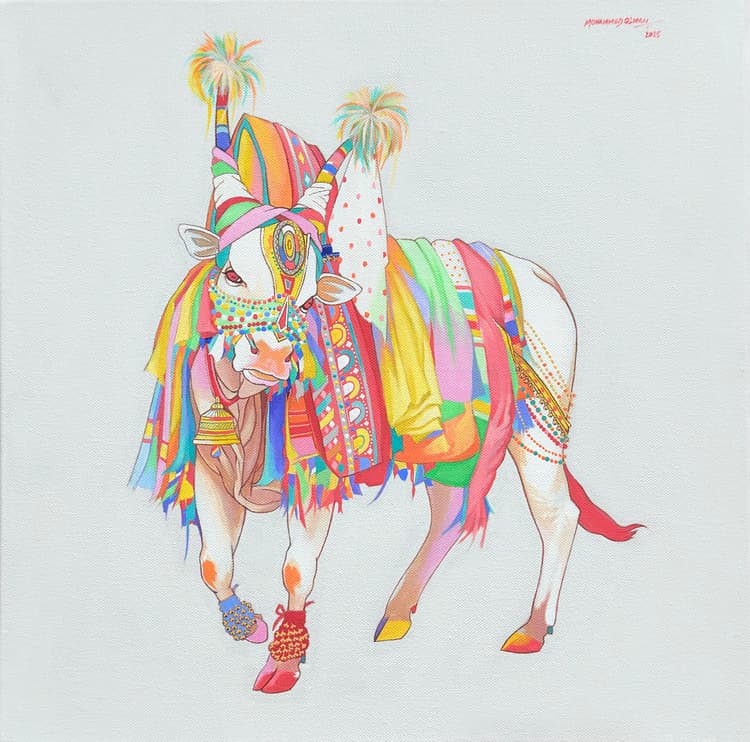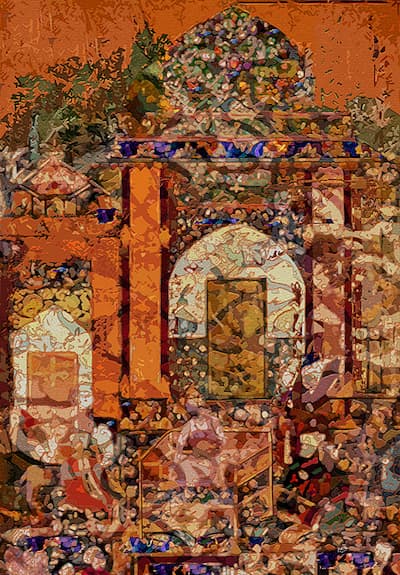Related Collections
Iconic Styles and Traditions of South Indian Art
Popular paintings of South India from the states of Kerala, Tamil Nadu, Karnataka, Andhra Pradesh and Telangana include:
Tanjore (Thanjavur) Paintings
Tanjore paintings took shape in the royal courts of Thanjavur, Tamil Nadu. You’ll recognize them instantly, the raised gesso work, the delicate gold leaf glow. Most depict scenes from Hindu mythology, serving both as devotional icons and ritual objects. While their aesthetics emerged from the patronage of Chola, Nayaka, and Maratha rulers, they also had influences from European and Deccani styles adding complexity to their visual narrative.
The art has been given Geographical Indication status, and the tradition continues today, with authentic artisans working in both traditional and modern motifs. Notable collections reside at Saraswathi Mahal Library and the Government Museum, Chennai.
Mysore Paintings
Mysore paintings are revered for their restrained elegance and earthy pigments, paintings that seem to breathe calm. Drawing from the artistic legacy of the Vijayanagara empire, the Wodeyar dynasty established Mysore as a hub for migratory artists. This helped foster the development of portraiture, illustrated manuscripts, and religious iconography.
Kalamkari Art
Kalamkari, a textile painting tradition from Andhra Pradesh and Telangana, is famed for its organic methods. Each cloth goes through as many as seventeen patient steps — drawn, washed, dyed, and drawn again. Kalamkari artists use natural dyes from plants, portraying epic scenes, nature, and cosmic symbols.
With the fusion of Persian, Mughal, and indigenous elements, two main schools emerged: Srikalahasti (hand-drawn pen work using bamboo or date palm sticks) and Machilipatnam (block-printed). Kalamkari's "Tree of Life," geometric forms, and narrative panels are instantly recognizable and a celebration of ecology and spiritual symbolism.
Kerala Mural Paintings
Walk into any old temple in Kerala and the walls come alive — Kerala murals that retell myth and memory. They’re one of the most iconic South Indian culture paintings. Emerging as early as the 8th century CE, they are painted in natural pigments across five symbolic hues (Panchvarna) and follow sacred iconographic rules. Subjects range from Krishna, Shiva, and goddess tales, and the unique color coding denotes divinity, power, or other spiritual attributes.
Modern revival projects and institutions like the Guruvayur Institute continue to preserve and teach these sacred techniques.
Contemporary South Indian Art
In studios from Chennai to Hyderabad, contemporary south indian arts are taking new forms. There’s often a play of contrast: lush rural landscapes with contemporary cityscapes, figurative storytelling alongside abstraction, and time-honored traditions interwoven with personal, introspective themes. They could also be a representational south india painting, featuring lesser known places, symbols or cultures.
Techniques often blend expressive line-work, intricate patterning, and tactile surfaces, creating a fresh visual language that bridges past and present. Some works tug at nostalgia; others speak to the restless pulse & questions of today. Today, contemporary South Indian art stands out for its layered storytelling, material inventiveness, and the ability to connect viewers to both place and emotion within a rapidly evolving cultural landscape.
Techniques Used in South Indian Art
Natural Colors and Dyes
Most painting and textile arts utilize vegetable dyes and mineral-based pigments. For example, Kalamkari employs pomegranate rinds for blacks, indigo for blues, and turmeric for yellows to create a vibrant yet subtle finish. Kerala mural artists still use laterite for red, coconut soot for black, rice powder for white, and mineral-based yellows and greens.
Gold Foil and Semi-Precious Stones
Both Tanjore and Mysore styles feature gesso (lime-based relief paste), overlaid with gold leaf and, occasionally, semi-precious stones or glass. The gesso is applied in layers to create raised surfaces before gold foiling, creating the characteristic three-dimensional glow of these paintings.
Stone Carving Techniques
Temple sculpture is intrinsic to South Indian culture, exemplified by the temple architecture of Hampi, Mahabalipuram, and Thanjavur. The stone carving tradition showcases the mastery of south Indian sculptures known for their temple facades, pillared halls, and monumental gopurams.
Bronze Casting – Lost-Wax Method
Chola bronzes, world-renowned for their sophistication, are created using the lost-wax (Madhuchishtavidhana) technique. This process ensures each icon is unique, with minute details added by skilled artisans. "Panchaloka" (alloy of five metals: copper, brass, lead, silver, and gold) is commonly used in sacred statues. The technique involves creating a wax model, covering it with clay, heating to melt the wax, and then pouring molten metal into the hollow mold.
Wood and Ivory Carving
Traditional South Indian artisans also excel in wood and ivory carving, making temple doors, household icons, and decorative panels. These crafts are particularly prominent in Kerala and Karnataka, where they adorn temples and palaces.
Textile and Fabric Art
South India is famed for its silk and cotton weaving traditions including Kanchipuram, Pochampalli, and Gadwal. Kalamkari panel fabrics and sarees combine textile artistry with narrative painting
Floor Art/Kolam
Kolam is an everyday, ritualistic floor design in Tamil culture, created by women using rice flour. These intricate geometric patterns symbolize prosperity, divinity, and cosmic order, and are connected to mathematical concepts of symmetry, tessellation, and infinity.
Notable Artists in Traditional and Contemporary South Indian Painting
Traditional Masters
C. Kondiah Raju pioneered Tanjore calendar art, blending traditional techniques with modern commercial appeal. Master craftsmen of the Raju and Nayudu communities who preserved Tanjore and Mysore painting lineages across generations. Raja Ravi Varma, was the bridge between the traditional forms like Tanjore and Mysore paintings and contemporary forms, one of the first artists to give human faces to the Indian gods fusing of European realism with Indian themes.
Modern and Contemporary
Kandi Narsimlu, Thota Vaikuntam, Laxman Aelay, and Kappari Kishan are renowned for capturing the differen aspects of the rural folk from Telangana and Andhra Pradesh. Siva Balan paints the Tamil Nadu we remember — the vendor with his wares, temple whispers, cattle crossing narrow streets, a mirror to the everyday moments that made home feel like home. Iruvan Karunakaran, captures the streets and people of Tamil Nadu and Andhra Pradesh in his contemporary impasto works. Manjunath Wali’s acrylic and water color works capture the Hampi ruralscpaes and landscapes in distinctly different ways. Mohammed Osman explores the culture of the Gangireddu and Haridasu in his pop-art styled exquisitely detailed paintings of the adorned oxen. Ramesh Gorjala and Arpitha Reddy are globally recognised and part of many private collections for their contemporary treatments of traditional south indian paintings like Kalamkari and Kerala Murals. Pramod Reddy paints the mythological themes in the style of Temple murals.
Why Buy South Indian Art from ArtFlute?
Authenticity and Quality
When you buy south indian art from ArtFlute, you’re choosing hand-painted originals and limited edition serigraphs, only real artistry. Every south indian artwork in our collection carries its own story and provenance. Curated selection from verified artists.
Convenience and Trust
Safe, insured, worldwide shipping. Extensive curated selection spanning multiple contemporary South Indian traditions. Expert guidance on provenance, care, and collection building.
FAQs About South Indian Art
What is the famous art in South India?
What is the famous art in South India?
Among the famous south Indian paintings, Tanjore paintings, Mysore paintings, Kalamkari art, Kerala murals, and Chola bronzes are celebrated globally.
What are the traditional crafts of South India?
What are the traditional crafts of South India?
Traditional crafts include silk weaving (Kanchipuram, Pochampalli), temple stone sculpture, textile painting (Kalamkari), kolam art, bronze casting, wood and ivory carving.
What materials are commonly used in South Indian art?
What materials are commonly used in South Indian art?
Natural stones, bronze alloys (Panchaloka), vegetable dyes from pomegranate, natural dyes & mineral pigments, silk, cotton, wood, gold leaf, gesso paste, and rice flour are the primary materials.
Where can I buy South Indian paintings online?
Where can I buy South Indian paintings online?
On ArtFlute you can browse our curated collection of authentic South Indian traditional paintings and other Indian art online, by over a hundred artists.
What is the price range for South Indian paintings?
What is the price range for South Indian paintings?
Prices vary from works starting at ₹20,000 up to ₹10,00,000 or more for a South Indian artist painting.

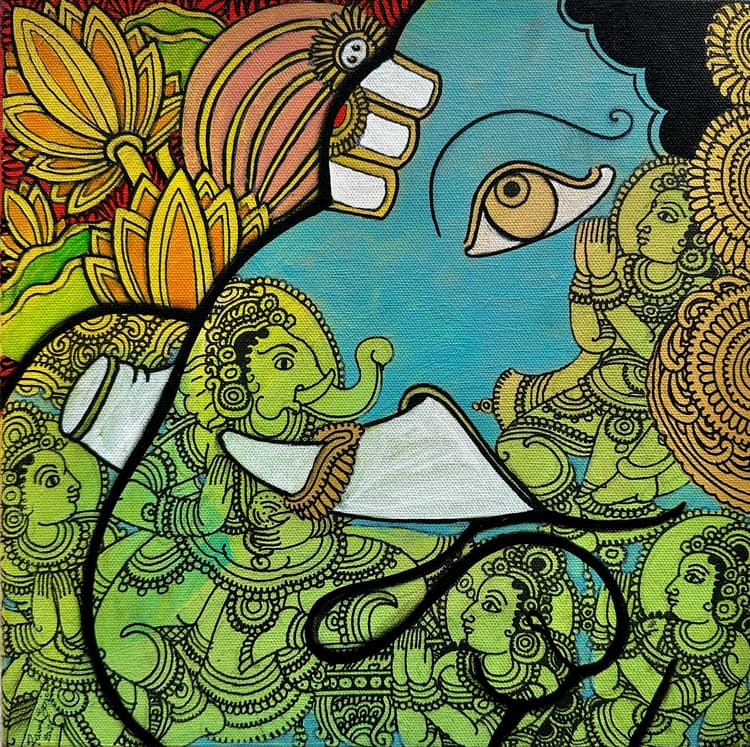
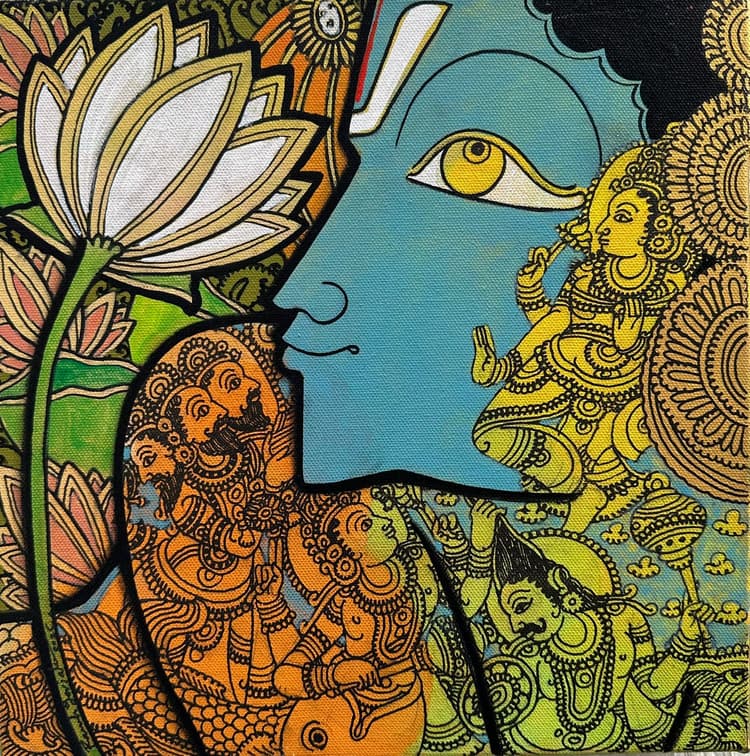
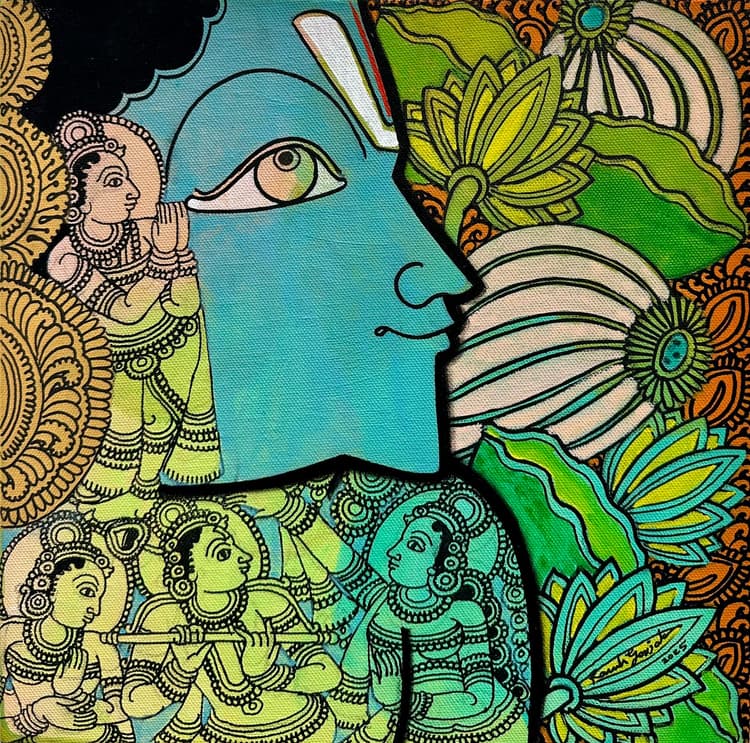

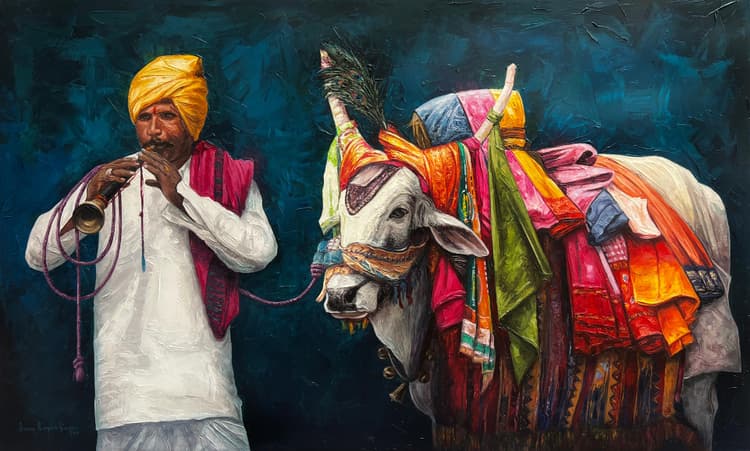
.jpg&w=750&q=75)






